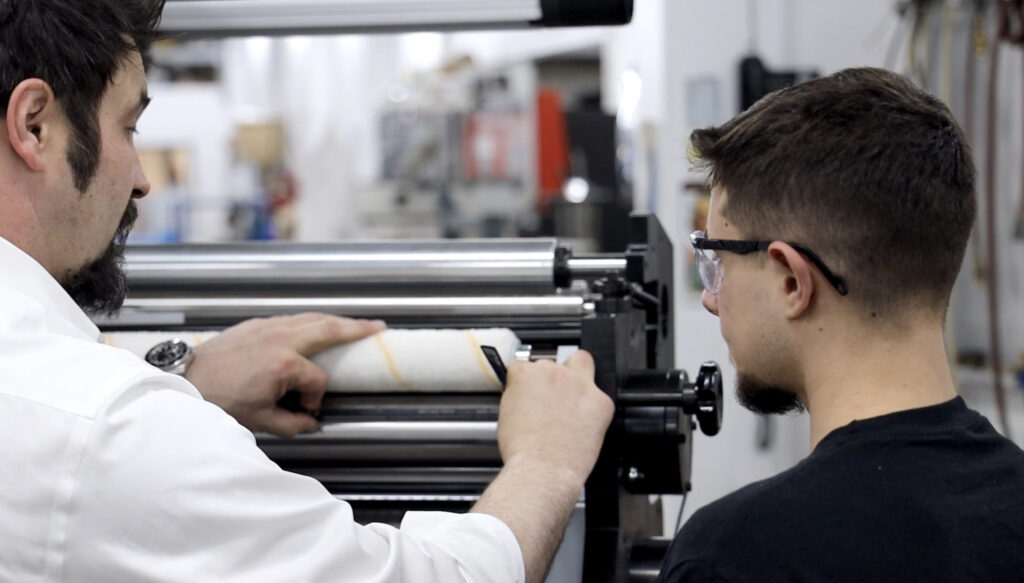Web finishing processes such as slitting require careful attention to matching the right type of slitting technique to the roll-fed material used, maintaining knife sharpness and dust levels, as well as preventing problems with roller alignment and using the right type of winding technique. By carefully evaluating all of these variables, web finishers can improve their slitting process for improved quality and efficiency.
Roller Alignment and Winding Techniques
In Improving Your Slitting Process: Part 1, we covered the importance of using the right slitting technique, knife sharpness, and dust levels; in this article, we will cover the importance of roller alignment and winding techniques.
Roller Alignment in Slitting Processes
The roller alignment is a critical aspect of the slit roll-making process and requires proper alignment of all rollers in all equipment the web comes into contact with. A rule of thumb in roller alignment is recognizing that the web travels at a 90° angle to the roller length. If misalignment occurs in two rollers, the web will shift on the path and develop wrinkles.
Misalignment of rollers leads to various types of wrinkles and problems such as:
- Hard wrinkles
- Web wrinkles
- Baggie Lane
- Shear asymmetric
- Roll interweaving
- CD web shifts
Performing regular preventive maintenance on roller alignment can prevent the development of wrinkles. Realignment can also correct a wrinkle problem that has occurred due to misalignment. A serious problem that occurs when a CD web force comes in contact with a razor blade is that breakage can occur as slitting blades are often very thin, which requires tight alignment control. A rough edge on a Shear knife can cause cutting edge damage and may also create excessive dust.
Misalignment in the roller feed will affect the slitting knives or blades and will also impact the dynamics of the winder pull tension and affect the web speed.
Winding Techniques for Slitting Processes
There are different winding techniques utilized for the rollers in slitting equipment; the basic winding techniques include:
- Center Winding
- Differential Rewinding
- Cores and Adaptors
- Individual Top Riding Rolls
- Surface-Center Winding
- Surface Winding
Center Winding
Center winding is necessary for some slitting processes where the material could become damaged or blocked if contact pressure cannot be applied. Center winding is a prevalent type of winding utilized in web finishing in slitting applications with the winding force solely derived from the rewind shaft, which is then transmitted to the winding web through the layers of material that have been rewound.
Differential Rewinding
Differential rewinding is utilized in many slitting processes as a duplex type of center winding. The duplex winder utilizes differential rewinding where each individual roll is isolated from others. This provides proper rewinding of materials of nonuniform gauge.
Cores and Adapters
The inside of cores must be square and smooth to the inside diameter, which is critical for obtaining proper rewinding. Any turned edges or burrs on the inside diameter of the core will cause binding, erratic slipping, and create unpredictable tensions on the web strip that is rewound.
Individual Top Riding Rolls
The top riding roll was developed as a refinement to multiple roll slitting processes and provides versatility with satisfactory winding at high speed. This type of winding provides constant contact with the roll rewinding, thus preventing air inclusions between film layers. Top riding rolls provide smooth sides and straight rewound rolls at low or high speed and are beneficial when winding off gauge, challenging materials.
Eliminate Air and Gauge Band Build-Up
Eliminating air inclusion during the winding and rewinding processes is critical to prevent problems with wrinkles, misalignment, and poor quality.
Many considerations come into play when optimizing a slitting process for maximum quality and efficiency. Speaking with an experienced web finishing equipment provider can help you to understand your options for precision slitting with quality and efficient processes.
Tamarack® Products has been a leading global supplier of quality web finishing and converting equipment for more than 50 years. We differ from other equipment suppliers in our technical expertise and commitment to customer satisfaction through value-added services. Contact us to learn more about improving your slitting process in your web finishing application.





